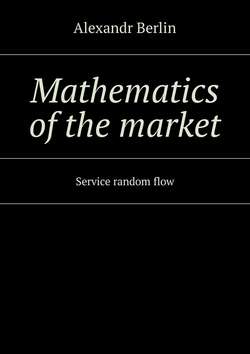Mathematics of the market. Service random flow

Реклама. ООО «ЛитРес», ИНН: 7719571260.
Оглавление
Alexandr Berlin. Mathematics of the market. Service random flow
Acronyms
Chapter 1. What are the REELECTION CONSUMPTION. unit of measure of supply and demand
1.1. So what is the goods?
1.2. Relative consumption
1.3. Factors affecting relative consumption
1.3. 1.Maximum consumption
1.3. 2.Real consumption (demand)
1.3. 3. The dependence of demand in units of relative consumption from the price
1.4. Numerical characteristics of flows supplies of goods
1.4.1. The intensity of the supplies of goods
1.5. The demand and its fluctuations
1.5.1. The basic definitions. The time of greatest demand
1.5.2. Main parameters and calculation of the intensity of demand
1.5.3. The average number of requests from one consumer per unit of time
1.5.4. Characteristics of quality of service of goods
1.5.5. Traffic-carrying capacity market
1.6. Tests to Chapter 1
Chapter 2. A mathematical model of the market
2. 1.Definition
2.2. Types of SERVICE systems and input flows goods
2.2.1. Types of systems service goods
2.2.2. The types of input flows
2.2.3. Principles of classification of event flows
2.2.4 Basic numerical characteristics of the flow of goods
2.2.5. The simplest flow of goods and its properties
2.2.6. Mathematical expectation and variance of a simplest flow
2.2.7. Distribution law of intervals between applications for the goods of the simplest stream
2.2.8. The duration of consumption. Flow of moments the end of consumption
2.3. Classification non-simplest flows
2.3. 1. flow with simple aftereffect
2.3.2. The flow repetitive supplies of goods
2.3.3. The flow with limited aftereffect
2.4. Tests to Chapter 2
Chapter 3. The market as a system with obvious losses
3.1.Statement of the problem
3.2. Differential equations Erlang
3.3. Stationary mode. Distribution of Erlang
3.4, Losses at service simplest flow with a fully the accessible group
3.5. Average throughput, consumer groups of the market with full accessibility
3.6. Graphical dependence between the parameters of the first formulas of Erlang
3.7. Example. The calculation the market of oil
3.8. Problems
3.9. Tests to Chapter 3
Chapter 4. The market as a system with waiting
4.1. The market model in the system with waiting. The output of the second formula Erlang
4.2. The probability of the system states
4.3. The probability that the time of storage will be more t
4.4. The average waiting time for batches of goods incoming on the market
4.5. The average waiting realization time for the saved goods
4.6. Probability of queue (probability of presence in the queue at least one batch of the goods)
4.7. The average queue length or the average number of delayed batches of goods
4.8. Example. The calculation of the market of oil with the storage of unsold goods
4.9 Problem
Chapter 5. Serving a fully accessible group of consumers from a group with a limited number of consignments (Engset formula)
5.1. Statement of the problem
5.2. The derivation of formula Engset
5.3. Types of losses in service flow from a limited number of sources
5.4. Problems
5.5. Questions for Tests
Glossary
APPENDIX 1 TABLES ENGSET
Reference
Отрывок из книги
A (Prelative). – relative consumption. The proposed load;
Aloss (t1, t2) – the difference between the incoming supply of goods and serviced supplies of goods;
.....
· the average number of requests for goods received from one group of consumers per unit time ;
· the average duration of consumption for maintenance of a single application of t.
.....